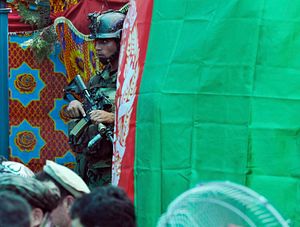For years since the end of U.S. combat operations in late 2014, the Afghan government has tightly held onto its official counts on the number of its police officers and soldiers that have been killed in action.
That changed this week, when Afghan President Ashraf Ghani provided the first official estimate since the end of the U.S. combat mission. According to the Afghan government, more than 28,000 forces — both police and Afghan National Army — have been killed in fighting with militants, including the Taliban and the Islamic State, since 2015.
“Since 2015, still much regrettable, but the entire loss of American forces in Afghanistan is 58 Americans. In the same period, 28,529 of our security forces have lost their lives,” Ghani said during a video conference speech from Kabul delivered to an audience in Washington, D.C., at the School of Advanced International Studies at Johns Hopkins University. (Ghani’s figure of 58 Americans may actually refer to U.S. and NATO troop casualties together.)
The admission comes amid growing concerns that the Afghan government is in control of less territory in Afghanistan than at anytime since the 2001 U.S. invasion that removed the Taliban government from power.
According to a report by the U.S. Special Inspector General for Afghanistan Reconstruction (SIGAR), a watchdog institution, the Afghan government as of the start of February 2018 controlled 229 districts, or just about 56.3 percent of Afghan districts.
The remainder were contested or under the control of the Taliban (29.2 percent were rated contested by SIGAR, while 14.5 percent were assessed as under full Taliban control).
As of November, Afghan government control had fallen slightly, to 55 percent of districts. In the meantime, the Taliban have made attempts to seize major urban nodes, including in August this year when they carried out a major campaign against the strategically located city of Ghazni, on the highway between Afghanistan’s capital, Kabul, and the second-largest city Qandahar.
Even with the large casualty counts for Afghan forces, Ghani denied that this meant the Taliban were winning. “Is the state at risk of collapse?” Ghani asked during the event this week. “No. Why? Because as long as we have our commando forces and our air force, we will be able to retake.”
“Are the losses horrific? Yes,” he added.
The conflict has largely been stalemated between both sides. The Afghan government has continued to emphasize its interest in arriving at a political solution, where the Taliban would set down its arms and participate politically in Afghan governance.
While Ghani’s assessment that the casualty rates might not lead to the collapse of the state might be accurate, there are questions about the sustainability of losses, which will affect not only the morale of Afghan forces, but also the rate at which recruiters might be able to shore up numbers for the Afghan National Army and police forces.

































